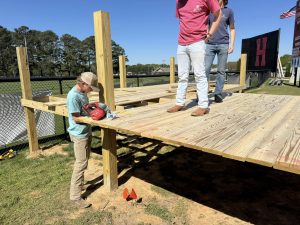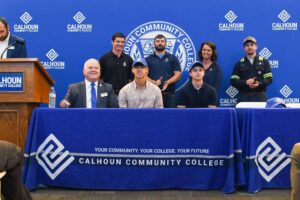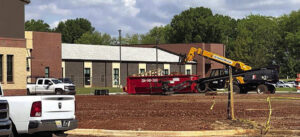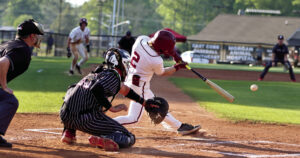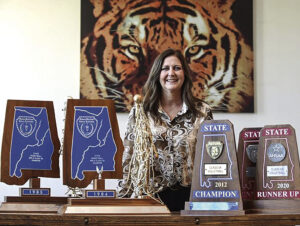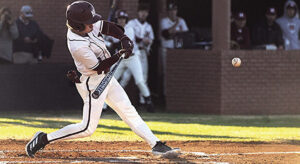Trip of a Lifetime
By Staff
Fishing in the Great White North is ‘perfect’ for local men
Mike Strickland, Special to the Enquirer
Every fisherman has a dream of a “fishing trip of a lifetime.” We may have found ours this year in a canoe trip, fishing in Quetico Park, Canada. Having fished in Canada for more than 20 years, I can tell you that something usually goes wrong on these trips: rain, wind, snow, bad camp sites, car trouble, lost luggage, broken rods, lost or wrong tackle and so on. But this trip was different: everything was perfect.
Quetico Park is an enormous governmental park located just north of Ely, Minn. This park is a fisherman’s dream; 60 miles wide by 50 miles deep and has thousands of lakes. Thinking about that a minute, you realize that, if you saw 100 lakes a year (which you couldn’t) it would take a lifetime to cover this place. Most larger lakes in the park have designated campsites but everything else is left up to you.
Trips into the park take planning and preparation for each person planning to go. This year, I was lucky to have Danny Smitherman and Steve Wood go with me. Both work with me at Buy-Rite Drugs, where the only trip outside is to lunch - if you’re lucky. We’re all in the business of pharmacy and camping trips are a welcome change of pace. Both guys are younger and stronger than me and can carry the canoes and camp gear better. I’m the kind of guy that carries the life jackets.
A trip to Quetico Park begins Jan. 1 the year you plan a trip. You must apply for a park entry permit for both an entry point and an entry date. This permit is good for up to eight people. The sooner you apply to this early date the more likely you are to get the entry date and entry point you want. Usually, you can get the entry point you want but you may have to move your date forward or backward a day or two.
Once you get a park entry date from the Canadian park service, you have four other documents you need to get through the trip and back home again. Each person needs a passport, a remote entry border pass from Canada, a re-entry permit from the U.S. and a Canadian fishing license. The best and easiest way to get the border passes is to apply for them through the mail three months before your entry date. If you need a passport, you can apply for it at the courthouse. Your Canadian fishing license is purchased at the game and fish office located at the border crossing. They offer both a sporting license and a conservation license. We usually get the conservation license.
Trying to get a bunch of guys to commit to a particular date in June, three to six months early, is like herding cats. If you can manage this, and get the four documents mentioned above, you will be set on documents. We’ve had last-minute changes for the past two years on who’s going and who’s not going and had to go to each country’s border crossing in International Falls, Minn. and Ft. Frances, Canada to apply for the permits. If you have to do this, better allow for an extra day on your trip.
We usually plan our trip either the first or second week in June. We’re fishing for smallmouth bass and they are either in the pre or post-spawn or are “hard on the bed” at that time. The water has warmed up to the upper 50s and the fish are more active than an earlier trip in May. Sometimes those northern pike and walleyes get in the way, but I guess that’s something we must endure.
You just don’t get in the truck and drive on this trip. You mainly plan for three things: camping, canoeing and fishing. We usually use an outfitter in Ely to supply our meals, canoes and major camping supplies. We have to bring our own camp and fishing equipment and therein lies the problem.
Most people have problems packing for a vacation in the trunk of a car. Our problem is how to pack camp gear and supplies, clothes and fishing gear into two canoes. The outfitter puts all our supplies in two large packs for the canoes. That leaves room for the tents, sleeping bags, rods and one back pack each. Any more than that and the canoe sinks and you go for a swim. Some campers pack light to make camp each night on different lakes. We go for comfort and carry more to that end and plan to make camp only once.
Guys really get weird when asked to put everything they will need for one week in one pack. It usually works best to meet about a month before your trip to decide what each will take. Let’s see: a quarter fishing lures, a quarter fishing supplies, and a half clothes. Or a third lures, third supplies and third clothes? We could starve so we better take candy, too. It could also rain for three days. So cut the clothes and end up with a quarter, lures, a quarter supplies, a quarter candy, books and playing cards and a quarter clothes.
Three shirts, pants and socks with two pair of fishing shoes should do it, right? We like to bring lightweight pants that convert to a pair of shorts if you need them. If we have room we take along a jacket and a pair of long johns. If it turns cold, you can put on everything you have and spend the day in the tent in the sleeping bag if you have to.
Our fishing gear usually consists of medium action rods, two spin casters and one bait caster for each fisherman. We usually do well with 6-pound mono. Our main lure is a 3/8 oz. Jig head with a three-inch chartreuse grub. The bass hit the chartreuse well and you can see how you are working the grub in the water. We’ve also used Rapala poppers, 6-inch black and chartreuse salamanders and silver rat-I-traps. If the northern are really hitting, you can use 6 to 12 inch clear or black 30-pound leaders. Remember, you cut your fishing tackle in the pack from a third to a quarter inch. Might have been better to leave out more clothes.
The average temperature is in the 40s to 50s at night and 70s to 80s during the day. One trip we were fishing in shorts in the morning and watched it snow in the evening. We’ve also had trips where we ran out of sunscreen and everyone came back tan or burned. The first year, I went to Quetico was in 1987. We were all energetic, fishing from daylight to dark. After three days, we were too tired to move. Seems we failed to notice that the sun is up at 5 a.m. and sets at 10:30 p.m. Now, we are much wiser. We try to cook and eat one hour for every hour we fish. It works much better this way for us and the fish.
One thing about Quetico you have to adjust to. The water is so clear you can see 15-20 feet when the sun is high in the sky. I’ve learned more about fishing in general from fishing in Canada than all my years in the colored waters of the U.S. You can see what’s going on below. Often times, you can spot a fish before you catch it. I’ve seen males make and patrol a bed. Females come in and lay out on a bed. Learned the “patrol” habits of the male bass guarding the bed. I’ve see 3 or 5-pound smallmouth school on minnows from moving from place to place for 30 minutes at a time (we caught a canoe full of those). I’ve hooked a bass and, on cranking in, ended up with a northern that had completely devoured the bass. We’ve caught northern as long as your leg, walleyes up to 6 pounds and smallmouth just south of 7 pounds. We have also caught bass in the pre-spawn with smaller Rapalas. Two trips we had only light winds and did well on the top water. A smallmouth on top water is really something. Some guys only fish with fly rods just for that reason. If you catch the fish on the bed you can catch the same fish over and over again with salamanders by setting the hook when they move the bait off the bed.
You can drift through weed beds or work longs with bait casters using leaders and silver rat-I-traps for a lot of fun with northern pike. The fin with northern pike begins when they can finally see the canoe and realize what’s going on. Larger northern can take up to 30 minutes to land. Don’t forget to use filet gloves. Their teeth and gill plates can quickly demote you to camp cook if you’re not careful.
Northern like to swim out quickly and turn back to get slack in the line, roll and cut the line. Just keep the line tight and work to keep their head facing the boat and you will get your photo op. Be careful what you wish for with northern. One year, my fishing partner wanted to take a 4-foot northern back to camp for pictures so we put the fish in the canoe. Well, the thing started flopping around so bad it almost tore up the whole boat before we could get it back in the water. That northern left the boat with eight lures of mine, none of which were in his mouth. Should have brought more lures in the pack that year.
If a smallmouth bass strike is a normal hit to you then a walleye strike would be like a whisper or a light tap. We catch walleye mostly during a light wind suspended in around 15 feet using grubs or leaches. You can go later in the summer in July and the walleye will come up from the shallows. You can catch them with 3.8 oz. jugs and the same chartreuse grubs.
Our trip to Ely takes 24 hours from Hartselle. We drive straight through and sleep in the outfitters camp house the night before the trip. Through trial and error, you learn where to stop for interesting places along the way. We usually stop at the “Red Barn” in Arcola, Ill. An Amish community where the ladies cook a buffet you won’t forget. We travel a route that keeps us out of the larger cities. Works better that way. If we get to Ely early enough, we spend the day walking around the town. There are some very interesting stores and sites there. The wolf museum and conservatory is very interesting. I can tell you, if you want to buy something for your girls back home don’t ever buy them muck-lucks…Alabama girls just don’t like them.
We usually try to get to the outfitters before dark. Go over fishing reports and make any last minute changes to our provisions and packs. It’s about this time we notice the mosquitoes. They are everywhere. We usually break out the repellant then and keep it out the whole time.
The morning of the trip begins at daylight with coffee, sausage and a stack of pancakes. It cost extra, but is well worth it, to use the motorboat to portage to Washington Island, the northernmost pint where outboard motors are allowed. It takes a day to canoe and make camp. Wood off of beaver houses makes the best firewood for camp. Time spent early on firewood means you get to eat everyday, even when it rains.
The weather for this unbelievable trip was 45 degrees at night and 80 degrees during the day, light wind and no rain. Each morning we took about two hours sitting around the lake, drinking coffee and cooking breakfast. Each day, we fished different lakes with some short portages to the lake. For two days, we took longer trips of 10 miles to new lakes in the park. We usually fished for about three hours, break for a shore lunch, fish for three hours more, then return to camp. Each person is allowed one bass, two walleyes and two northern on a conservation license. Each night we brought back one bass back to camp for supper. I usually started cooking supper while Steve and Danny filleted the fish.
Our average day consisted of 30 bass up to 5 pounds and five northern each. Our best day was in a smaller warmer lake with little wind. Never have I caught so many bass on top water poppers. Bring one back to the canoe and five others were following. In two hours, we each caught 30 bass from 3-and-a-half inches to 5 pounds on top water. What a day!
At the end of the trip, we all packed out and met our outfitter at Washington Point where we were portages back to the lodge for a warm shower and a meal. I was craving a Big Mac combo. After saying our goodbyes, we began our overnight drive back to home and pharmacy in Alabama. I mentioned earlier that everything was perfect. We had great weather, good food, big fish and good friends. It just doesn’t get any better than that.


